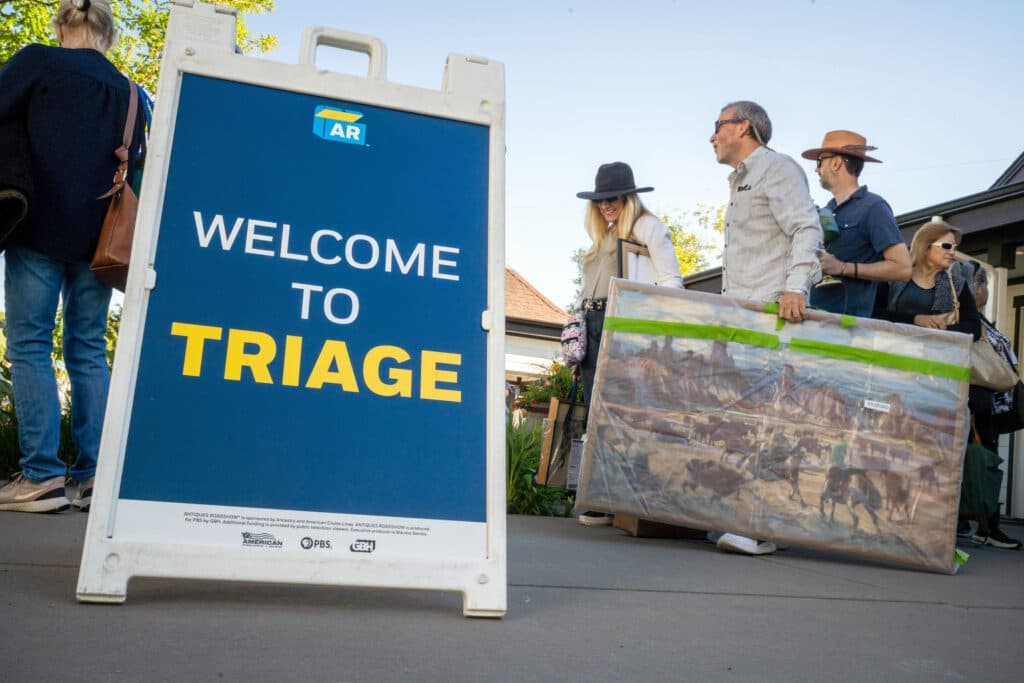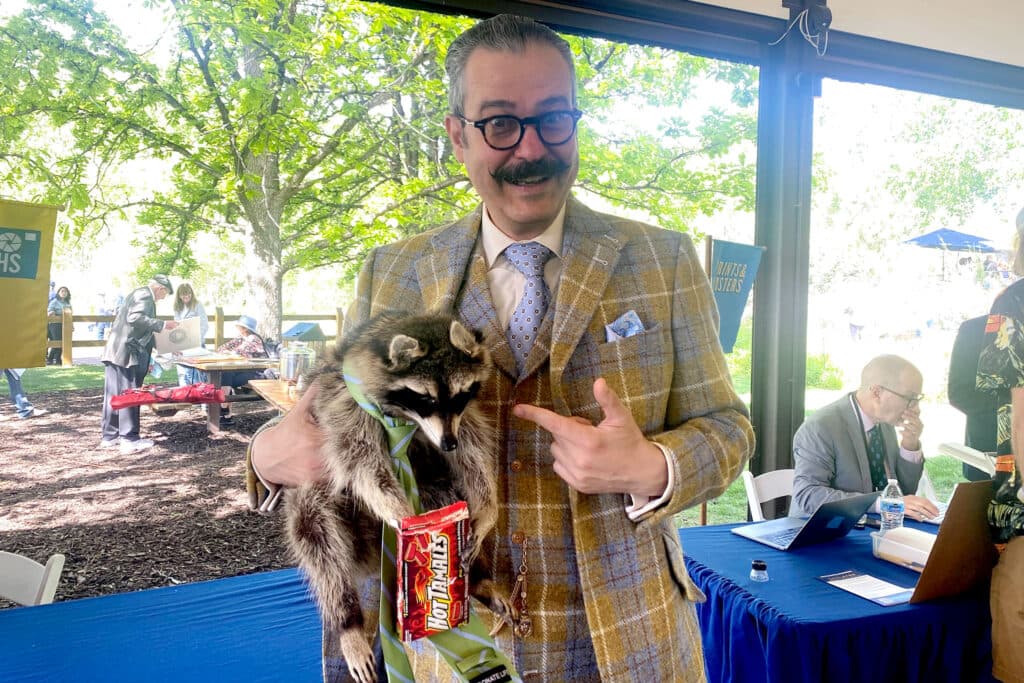Nothing but a blue sheet covered the fossilized femur of a long-extinct wooly mammoth that came into Jay’s family about 10 years ago.
“Lately it's been sitting under the pool table, but I've been meaning to build a proper display case for it,” he said.
The femur is one of thousands of treasures taken to a tour stop for the long-running PBS show Antiques Roadshow at the Denver Botanic Gardens’ Chatfield Farms location in Littleton on Wednesday.
It was the Roadshow’s first stop in the Denver area in 15 years. Over 20,000 people applied for tickets, and only 4,000 got admitted by random lottery.
Crews filmed all day, and will eventually air the footage across three episodes that will premiere early next year.
By 10 a.m., hundreds of hopefuls were lined up at the event.

Some were looking for money, but many more looking for a story — about family heirlooms passed down by ancestors, weird items picked up at a thrift store or personal collections an owner spent decades building.
Many fashioned makeshift containers or carts to carry jewelry, art, furniture and countless other objects that have borne witness to centuries of American (and, in some cases, global) history.
To learn more about the process, Denverite brought two items to be appraised.
Those with tickets to Antiques Roadshow’s Littleton tour stop were invited to bring two items of their choosing to get appraised. PBS and WGBH Boston, the producers of the program, fly out dozens of volunteer appraisers, all with their own set of specialties.
With us is Rocky the Raccoon, a taxidermied raccoon that for some reason is sticking its paws into a box of Hot Tamales candies.

Colorado Public Radio climate editor Joe Wertz brought the taxidermied creature into the office last October.
Wertz told colleagues that he watched a box fall out the back of a truck, and when he picked it up, he found Rocky’s lifeless eyes staring back at him. After dressing him up in a tie, we set out to learn more about its market value.
The second is a mezuzah — a Hebrew prayer that is typically fixed to the doorpost of Jewish people’s homes — that Denverite reporter Rebecca Tauber inherited from her great-grandmother who immigrated from Poland in the 1920s. We wanted to learn more about its history and where it might have originated from.

After attendees are checked in, they’re sent to triage, where appraisers categorize each item and send people to specialized tents to get a full evaluation.
Both Rocky and the mezuzah were categorized as collectibles and directed to Travis Landry, an auctioneer from Rhode Island who specializes in all things pop culture.
Before Landry assessed our items, he began with a disclaimer, which he described as the ‘golden rule.’
“As we always like to say, the story and sentimental value is priceless,” he said.
Landry, who studied nuclear engineering before finding his way into the auctioneering business, said there’s no formal training to becoming a professional appraiser. He grew up going to auctions as a kid with his parents, and said it was his childhood dream to appraise items on Antiques Roadshow.
The oldest item he has ever appraised was a piece of an asteroid.
“The best thing is hands-on experience, getting in the trenches, buying, selling, going to auctions, feeling, touching, sniffing it, and just embodying the trade,” he said.
Landry started with Rocky the Raccoon — but stopped short of sniffing it.

“This looks like he just came out of the [Secret Life of Pets] movie or the zoo,” Landry said. “He looks alive and well. So [a] world of value at auction, because he is so unusual. I would say this is going to bring about $200 to $300 today.”
Landry explained that taxidermy has lost stock in the 21st century. Not many people care for stuffed animal corpses to be present in their lives anymore.
So while whoever commissioned the taxidermied, candy-loving raccoon likely paid several hundred dollars, maybe even up to $1,000, it isn’t likely to fetch that price in an auction or at a pawn shop.

The mezuzah was harder to pin down. The prayer case had little markings on it, with the most notable being a Hebrew letter inscribed. Without many clues about an item’s history, Landry said it’s difficult to ascertain much about it. But, he was able to make some educated guesses.
“When you look at how this is pressed and it's die cut, and this is embossed here, I would guess it's probably [made in] the United States,” Landry said. “I don't know if they had that really kind of industrial ‘oomph’ in Poland in 1920.”
With an understanding of the process, we set out to explore what others brought.
Just a couple tables away from Landry was Bill.
(Like all participants, Antiques Roadshow had instructed him to only give his first name for safety reasons — just in case something appraised is particularly valuable.)
Bill had brought his friend’s baseball, signed by every member of the 1968 World Series-winning Detroit Tigers. An appraiser helped Bill date the ball and assess the quality of the signatures, estimating that it could be worth between $2,500 and $5,000.
“It’s a true team signed ball, which is rare,” said Jasmani Francis, an appraiser from Arizona who specializes in sports memorabilia, before reciting baseball facts from memory.

One person used the opportunity to confirm that a pair of spears his father found in a barn in Iowa did indeed originate from Africa.
Some items, like a pair of carved wooden busts from Bali, looked exotic but were ultimately determined to be the 1930s version of tourism souvenirs.
Brian was waiting in line pushing a cart carrying two distinct items. The first was a bronze statue removed from the Paramount Theater in downtown Denver when his family owned it decades ago. The second item was a duo of spears of unknown origin that he bought from a woman off Craigslist.
“She said she thinks they're cursed, so she wanted someone to take 'em,” he said.

During his short time with the spears, he hasn’t seen any signs of a curse. The opposite, actually.
“I’ve had good things happen.”
Further back in the line, one participant, Lane, brought in dozens of emblems he took off abandoned cars in the 1960s and 1970s. His favorite is one belonging to the Ford Edsel, which was discontinued in 1960.
“I have no idea what they’re worth,” said Lane, who currently drives a 1955 Chevrolet Bel Air. “I could identify cars when I was two [years old].”
For many, Antiques Roadshow stop in Denver provided a rare opportunity to connect with their ancestors and history.
Marsha Bemko has worked on Antiques Roadshow since season four was shot in 1999. She now works as the show’s executive producer.
While the antiques are the obvious centerpiece, she said the show has achieved its longevity because of the people who bring the items.
“I like that about Roadshow. It's not all about the antiques, it's about the people here too,” Bemko said.

Another joy of the show for Bemko is how everyone has their own collectibles and types of items they’re drawn to.
“Some of us like militaria. Some of us like paintings. I like diamonds,” she said. “So if I were going to see something that I would want that I can't have because it's theirs, it would be a huge honkin' diamond.”
Many of the attendees Denverite spoke to had no desire to sell their possessions — instead, many wanted to learn more about their items or feel closer to family.
Wanda came to the tour stop despite knowing the value of her possession: a vase her mom was gifted after she helped a tribal member of the Pueblo of Isleta in New Mexico baptize her baby.
“It was really more of just coming out here and being able to be a part of the Antiques Roadshow experience and then just being able to pass along my mom's story to somebody else and then share this story back with my mom and let her know this is what they told me about her pot,” she said.

Alice had brought a vase from East Asia that her grandparents were gifted during their wedding in 1921. She carried with her a note from her mother which explained how they came into ownership of the artifact.
“I think we really need to appreciate where we've come from and we need to keep that alive. And we do that by talking about it, hearing the stories,” she said.
Nicholas Lowry, a third-generation appraiser and auction house owner, specializes in antique posters, which he collects with his father.
Even though his entire life is dictated by antiquing, he still finds inspiration from the practice.
“Personally, it's my aesthetic, it’s the life I lead,” Lowry said, dressed in a custom vintage-style plaid suit complete with a twirled mustache and pocket watch. “I think anybody who doesn't like old stuff is wrong and mistaken … It's a gateway to another era. It's seeing things that don't exist anymore. It's stories that haven't been told in generations.”














